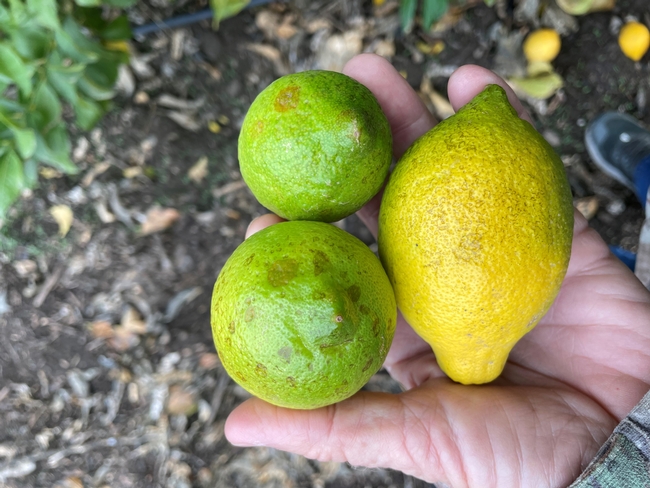A recent call came through inquiring about the cause of “water spotting” or "staining" on lemons from a coastal orchard. The orchard was sprayed for pests using a horticultural oil in October and at harvest, the spotting was noted. The guidelines for oil use are to avoid use when temperatures exceed 90 deg or so and when it gets cold or is forecast to get cold. The cold injunction is because that fruit mass causes condensation which leads to the spotting. It should never be used when frost is forecast either. The problem along the coast is the weather is about as fickle as weather can get anywhere in the state. Hot one day and cold the next. You can break the rules 9 out of 10 times and get away with it, but according to our Advisor Craig Kallsen in Kern, you get caught the one time when you break the rule.
Oil sprays are an important component in citrus IPM programs for the control of armored and soft scales, aphids, leafminers, and certain species of mites. When used alone, they may be applied using outside coverage (OC) for aphids, leafminers or mites, intermediate coverage (IC) if used for soft scales, and thorough coverage (TC) if used for armored scales at rates of 1 to 6% depending on the crop, time of year and the target pest. Oils are frequently used at rates of 0.25 to 1% in combination with other insecticides. Because petroleum oils can cause phytotoxicity, the following precautions are important:
- Soil moisture should be maximum before application; spray as soon after an irrigation as the ground will permit operation of the equipment. Be sure to maintain adequate soil moisture from spring throughout the entire irrigation season.
- Do not spray oils when temperatures exceed 95°F or relative humidity falls to 20% or below (in coastal regions, do not spray if the temperature will exceed 85° to 90°F or the relative humidity goes below 30%); also do not use oil sprays immediately before, during, or following an unusually cold weather period.
- Problems of leaf drop and fruit drop can be minimized, in general, by adding 2,4-D to the oil spray mixture. Be careful not to apply 2,4-D within 2 miles of sensitive crops such as tomatoes, cotton, olives, and grapes and do not use 2,4-D during spring to avoid phytotoxicity problems.
- If navel orange orchards are sprayed with oil when oranges are approaching maturity, generally from November until harvest, protection against water spot may be obtained by using gibberellic acid. (Caution: fall oil sprays may increase the risk of damage caused by frost).
- Complete coverage of the tree with an oil spray provides more effective control than increased dosage. If spraying is done by ground, equip the rig with a tower capable of elevating a sprayer 4 feet above the tallest trees.
- Generally, narrow range oils with a 50% distillation range of 415 to 455 are recommended for use in citrus.
- The heavier the oil is (e.g., NR 440 is heavier than NR 415), the better its insecticidal properties will be, but also the greater the potential for phytotoxicity to the tree.
Precautions for Using Petroleum Oil Sprays from UC Integrated Pest Management website
